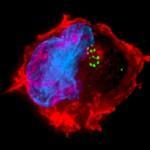Conventional T cells (which have an alpha:beta T cell receptor) make up the majority of T cells in the peripheral circulation and lymphoid tissues. A minor population of T cells are the gamma-delta T cells, which have very low expression, or lack the CD4 receptor. Up until now, these cells have thus not been considered to harbour latent HIV, and serve as a reservoir, even though infection of these cells have been reported.
Successful elimination of HIV, leading to a cure, will need to identify all celluar reservoirs that harbour latent virus. In the October edition of PloS Pathogens, Natalia Soriano-Sarabia et al have found that upregulation of the CD4 receptor may render primary Vδ2 cells target for HIV infection in vitro and they propose that HIV-induced immune activation may allow infection of γδ T cells in vivo.
The authors assessed the presence of latent HIV infection by measurements of DNA and outgrowth assays within Vδ2 cells in 18 aviremic patients on long-standing antiretroviral therapy. They recovered latent but replication-competent HIV from highly purified Vδ2 cells from 14 HIV+ subjects. This demonstrated that “peripheral Vδ2 T cells are a previously unrecognized reservoir in which latent HIV infection is unexpectedly frequent”.
